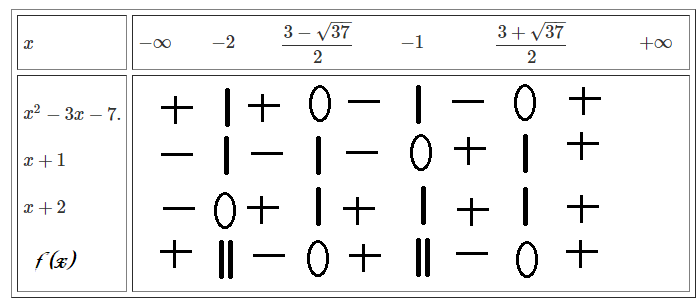Giải pt sau
1/(x-2)+3=(3x-2)/(x+2)
Hãy nhập câu hỏi của bạn vào đây, nếu là tài khoản VIP, bạn sẽ được ưu tiên trả lời.


1) Ta có: \(\sqrt{21-x}+1=x\)
\(\Leftrightarrow21-x=\left(x-1\right)^2\)
\(\Leftrightarrow x^2-2x+1-21+x=0\)
\(\Leftrightarrow x^2-3x-20=0\)
\(\text{Δ}=\left(-3\right)^2-4\cdot1\cdot\left(-20\right)=9+80=89\)
Vì Δ>0 nên phương trình có hai nghiệm phân biệt là:
\(\left\{{}\begin{matrix}x_1=\dfrac{3+\sqrt{89}}{2}\\x_2=\dfrac{3-\sqrt{89}}{2}\end{matrix}\right.\)
1)\(\sqrt{21-x}+1=x\)
\(\Leftrightarrow21-x=\left(x-1\right)^2\)
\(\Leftrightarrow21-x=x^2-2x+1\)
\(\Leftrightarrow x^2-x-20=0\)
\(\Leftrightarrow\left(x-5\right)\left(x+4\right)=0\)
\(\Leftrightarrow\left[{}\begin{matrix}x-5=0\\x+4=0\end{matrix}\right.\Leftrightarrow\left[{}\begin{matrix}x=5\\x=-4\end{matrix}\right.\)
2)\(\sqrt{8-x}+2=x\)
\(\Leftrightarrow8-x=\left(x-2\right)^2\)
\(\Leftrightarrow8-x=x^2-4x+4\)
\(\Leftrightarrow x^2-3x-4=0\Leftrightarrow\left(x-4\right)\left(x+1\right)=0\)
\(\Leftrightarrow\left[{}\begin{matrix}x=4\\x=-1\end{matrix}\right.\)

`1)x^4 -10x^3 +26x^2 -10x+1=0`
`x=0=>VT=1=>x=0(l)`
Chia 2 vế cho `x^2>0` ta có
`x^2-10x+26-10/x+1/x^2=0`
`=>x^2+1/x^2+26-10(x+1/x)=0`
`=>(x+1/x)^2-10(x+1/x)+24=0`
Đặt `a=x+1/x`
`pt<=>a^2-10a+24=0`
`<=>` $\left[ \begin{array}{l}a=4\\a=6\end{array} \right.$
`a=4<=>x+1/x=4<=>x^2-4x+1=0<=>` $\left[ \begin{array}{l}x=\sqrt3+2\\x=-\sqrt3+2\end{array} \right.$
`a=6<=>x+1/x=6<=>x^2-6x+1=0<=>` $\left[ \begin{array}{l}x=\sqrt8+3\\x=-\sqrt8+3\end{array} \right.$
Vậy `S={\sqrt3+2,-\sqrt3+2,\sqrt8+3,-\sqrt8+3}`
2)Do hệ số chẵn bằng=hệ số lẻ
`=>x=-1`
`pt<=>x^4+x^3+4x^3+4x^2+6x^2+6x+9x+9=0`
`<=>(x+1)(x^3+4x^2+6x+9)=0`
`<=>(x+1)(x^3+3x^2+x^2+6x+9)=0`
`<=>(x+1)[x^2(x+3)+(x+3)^2]=0`
`<=>(x+1)(x+3)(x^2+x+3)=0`
Do `x^2+x+3=(x+1/2)^2+11/4>0`
`=>` $\left[ \begin{array}{l}x=-3\\x=-1\end{array} \right.$
Vậy `S={-1,-3}`

1) \(\sqrt{5-2x}=6\left(đk:x\le\dfrac{5}{2}\right)\)
\(\Leftrightarrow5-2x=36\)
\(\Leftrightarrow2x=-31\Leftrightarrow x=-\dfrac{31}{2}\left(tm\right)\)
2) \(\sqrt{2-x}=\sqrt{x+1}\left(đk:2\ge x\ge-1\right)\)
\(\Leftrightarrow2-x=x+1\)
\(\Leftrightarrow2x=1\Leftrightarrow x=\dfrac{1}{2}\left(tm\right)\)
3) \(\Leftrightarrow\sqrt{\left(2x+1\right)^2}=6\)
\(\Leftrightarrow\left|2x+1\right|=6\)
\(\Leftrightarrow\left[{}\begin{matrix}2x+1=6\\2x+1=-6\end{matrix}\right.\)
\(\Leftrightarrow\left[{}\begin{matrix}x=\dfrac{5}{2}\\x=-\dfrac{7}{2}\end{matrix}\right.\)
4) \(\sqrt{x^2-10x+25}=x-2\left(đk:x\ge2\right)\)
\(\Leftrightarrow\sqrt{\left(x-5\right)^2}=x-2\)
\(\Leftrightarrow\left|x-5\right|=x-2\)
\(\Leftrightarrow\left[{}\begin{matrix}x-5=x-2\left(x\ge5\right)\\x-5=2-x\left(2\le x< 5\right)\end{matrix}\right.\)
\(\Leftrightarrow\left[{}\begin{matrix}5=2\left(VLý\right)\\x=\dfrac{7}{2}\left(tm\right)\end{matrix}\right.\)

\(\dfrac{x-2}{x+1}-\dfrac{3}{x+2}>0.\left(x\ne-1;-2\right).\\ \Leftrightarrow\dfrac{x^2-4-3x-3}{\left(x+1\right)\left(x+2\right)}>0.\\ \Leftrightarrow\dfrac{x^2-3x-7}{\left(x+1\right)\left(x+2\right)}>0.\)
Đặt \(f\left(x\right)=\dfrac{x^2-3x-7}{\left(x+1\right)\left(x+2\right)}>0.\)
Ta có: \(x^2-3x-7=0.\Rightarrow\left[{}\begin{matrix}x=\dfrac{3+\sqrt{37}}{2}.\\x=\dfrac{3-\sqrt{37}}{2}.\end{matrix}\right.\)
\(x+1=0.\Leftrightarrow x=-1.\\ x+2=0.\Leftrightarrow x=-2.\)
Bảng xét dấu:

\(\Rightarrow f\left(x\right)>0\Leftrightarrow x\in\left(-\infty-2\right)\cup\left(\dfrac{3-\sqrt{37}}{2};-1\right)\cup\left(\dfrac{3+\sqrt{37}}{2};+\infty\right).\)
\(\sqrt{x^2-3x+2}\ge3.\\ \Leftrightarrow x^2-3x+2\ge9.\\ \Leftrightarrow x^2-3x-7\ge0.\)
\(\Rightarrow\left[{}\begin{matrix}x=\dfrac{3-\sqrt{37}}{2}.\\x=\dfrac{3+\sqrt{37}}{2}.\end{matrix}\right.\)
Đặt \(f\left(x\right)=x^2-3x-7.\)
\(f\left(x\right)=x^2-3x-7.\)
\(\Rightarrow f\left(x\right)\ge0\Leftrightarrow x\in(-\infty;\dfrac{3-\sqrt{37}}{2}]\cup[\dfrac{3+\sqrt{37}}{2};+\infty).\)
\(\Rightarrow\sqrt{x^2-3x+2}\ge3\Leftrightarrow x\in(-\infty;\dfrac{3-\sqrt{37}}{2}]\cup[\dfrac{3+\sqrt{37}}{2};+\infty).\)

1.Pt \(\Leftrightarrow cos\left(2x-\dfrac{\pi}{3}\right)=sin\left(x+\dfrac{\pi}{3}\right)\)
\(\Leftrightarrow cos\left(2x-\dfrac{\pi}{3}\right)=cos\left(\dfrac{\pi}{6}-x\right)\)
\(\Leftrightarrow\left[{}\begin{matrix}2x-\dfrac{\pi}{3}=\dfrac{\pi}{6}-x+k2\pi\\2x-\dfrac{\pi}{3}=x-\dfrac{\pi}{6}+k2\pi\end{matrix}\right.\)\(\left(k\in Z\right)\)
\(\Leftrightarrow\left[{}\begin{matrix}x=\dfrac{\pi}{6}+\dfrac{k2\pi}{3}\\x=\dfrac{\pi}{6}+k2\pi\end{matrix}\right.\)\(\left(k\in Z\right)\)
\(\Rightarrow x=\dfrac{\pi}{6}+\dfrac{k2\pi}{3}\)\(\left(k\in Z\right)\)
2.\(sin^22x+cos^23x=1\)
\(\Leftrightarrow\dfrac{1-cos4x}{2}+\dfrac{1+cos6x}{2}=1\)
\(\Leftrightarrow cos6x=cos4x\)
\(\Leftrightarrow\left[{}\begin{matrix}x=k\pi\\x=\dfrac{k\pi}{5}\end{matrix}\right.\)\(\left(k\in Z\right)\)\(\Rightarrow x=\dfrac{k\pi}{5}\)\(\left(k\in Z\right)\) (Gộp nghiệm)
Vậy...
3. \(Pt\Leftrightarrow\left(sinx+sin3x\right)+\left(sin2x+sin4x\right)=0\)
\(\Leftrightarrow2.sin2x.cosx+2.sin3x.cosx=0\)
\(\Leftrightarrow2cosx\left(sin2x+sin3x\right)=0\)
\(\Leftrightarrow\left[{}\begin{matrix}cosx=0\\sin3x=-sin2x\end{matrix}\right.\)\(\Leftrightarrow\left[{}\begin{matrix}x=\dfrac{\pi}{2}+k\pi\\sin3x=sin\left(\pi+2x\right)\end{matrix}\right.\)(\(k\in Z\))
\(\Leftrightarrow\left[{}\begin{matrix}x=\dfrac{\pi}{2}+k\pi\\x=\pi+k2\pi\\x=\dfrac{k2\pi}{5}\end{matrix}\right.\)(\(k\in Z\))\(\Rightarrow\left[{}\begin{matrix}x=\dfrac{\pi}{2}+k\pi\\x=\dfrac{k2\pi}{5}\end{matrix}\right.\) (\(k\in Z\))
Vậy...
4. Pt\(\Leftrightarrow\dfrac{1-cos2x}{2}+\dfrac{1-cos4x}{2}=\dfrac{1-cos6x}{2}\)
\(\Leftrightarrow cos2x+cos4x=1+cos6x\)
\(\Leftrightarrow2cos3x.cosx=2cos^23x\)
\(\Leftrightarrow\left[{}\begin{matrix}cos3x=0\\cosx=cos3x\end{matrix}\right.\)\(\Leftrightarrow\left[{}\begin{matrix}x=\dfrac{\pi}{6}+\dfrac{k\pi}{3}\\x=-k\pi\\x=\dfrac{k\pi}{2}\end{matrix}\right.\)\(\left(k\in Z\right)\)\(\Rightarrow\left[{}\begin{matrix}x=\dfrac{\pi}{6}+\dfrac{k\pi}{3}\\x=\dfrac{k\pi}{2}\end{matrix}\right.\)\(\left(k\in Z\right)\)
Vậy...

ta có : x^5+2x^4+3x^3+3x^2+2x+1=0
\(\Leftrightarrow\)x^5+x^4+x^4+x^3+2x^3+2x^2+x^2+x+x+1=0
\(\Leftrightarrow\)(x^5+x^4)+(x^4+x^3)+(2x^3+2x^2)+(x^2+x)+(x+1)=0
\(\Leftrightarrow\)x^4(x+1)+x^3(x+1)+2x^2(x+1)+x(x+1)+(x+1)=0
\(\Leftrightarrow\)(x+1)(x^4+x^3+2x^2+x+1)=0
\(\Leftrightarrow\)(x+1)(x^4+x^3+x^2+x^2+x+1)=0
\(\Leftrightarrow\)(x+1)[x^2(x^2+x+1)+(x^2+x+1)]=0
\(\Leftrightarrow\)(x+1)(x^2+x+1)(x^2+1)=0
VÌ x^2+x+1=(x+\(\dfrac{1}{2}\))^2+\(\dfrac{3}{4}\)\(\ne0\) và x^2+1\(\ne0\)
\(\Rightarrow\)x+1=0
\(\Rightarrow\)x=-1
CÒN CÂU B TỰ LÀM (02042006)
b: x^4+3x^3-2x^2+x-3=0
=>x^4-x^3+4x^3-4x^2+2x^2-2x+3x-3=0
=>(x-1)(x^3+4x^2+2x+3)=0
=>x-1=0
=>x=1

=>\(\dfrac{x^2-3x+6-x^2+3x-6}{\sqrt{x^2-3x+6}-\sqrt{x^2-3x+3}}=3\)
=>căn x^2-3x+6-căn x^2-3x+3=1
Đặt x^2-3x+3=a
=>căn a+3-căn a=1
=>a+3+a-2căn a^2+3a=1
=>2*căn (a^2+3a)=2a+3-1=2a+2
=>căn a^2+3a=a+1
=>a^2+3a=a^2+2a+1
=>a=1
=>x^2-3x+2=0
=>x=1 hoặc x=2

Bạn tham khảo thêm ở link sau:
https://hoc24.vn/cau-hoi/giai-phuong-trinhsqrt3x2-5x1-sqrtx2-2sqrt3leftx2-x-1right-sqrtx2-3x4.167769342831

\(PT\Leftrightarrow3^x+2^x-3x-2=0\left(1\right)\)
Ta thấy \(x=0;x=1\) là nghiệm của \(\left(1\right)\)
Xét hàm \(f\left(x\right)=3^x+2^x-3x-2,x\in R\\ f'\left(x\right)=3^x\ln3+2^x\ln2-3\\ f''\left(x\right)=3^x\ln^23+2^x\ln^22>0,\forall x\)
Bề lõm của \(f\left(x\right)\) luôn hướng về \(y>0\) nên đồ thị ko thể cắt trục hoành tại nhiều hơn 2 điểm
Vậy nghiệm PT là \(x=0;x=1\)
cách làm :
đặt điều kiện xác định
quy đồng rồi khử mẫu (x-2)(3x-2)
phân tích các số trong ngoặc ra rồi giải phương trình
( phương trình là phương trình bậc 2 nên ko khó giải lắm )
Chúc bạn học giỏi
Tích mk nhoa !!!! ~~
mk ghi nhầm đó bạn
chỗ kia là khử mẫu (x-2)(x+2) chứ ko phải là (x-2)(3x-2) đâu